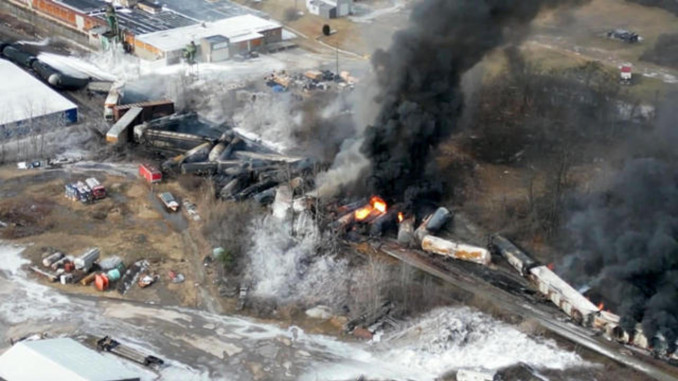
The Norfolk Southern (NS) train wreck in East Palestine on February 3, 2023, brought to light the railroad companies’ appalling disregard for safety. Eleven cars carrying toxic chemicals went off the track and burst into flames. Five thousand people had to be evacuated. The National Transportation Safety Board said “the accident was 100% preventable.” Not only was it not prevented, but rail wrecks like this are inevitable because railroads like NS are too cheap to install sufficient equipment to detect overheated wheel bearings before they fail and cause their trains to jump the tracks. In the words of East Palestine resident Stella Gamble, “Everything that’s happened here is the same as it is everywhere else in this country. It’s all about the money. […] Everything about it is the money, and they will gladly sacrifice a few thousand Appalachians.”
Residents of East Palestine are justifiably skeptical of the federal government’s claims that everything is fine and there is no need to worry. Unmistakable chemical odors continue to reappear regularly in the town’s air; and people suffer from ongoing and unexplained respiratory diseases, rashes, vomiting, migraines, and other symptoms. Some residents are unable to work due to ongoing medical conditions that appeared after the derailment. Even many of those who are feeling fine for now consider their surroundings to be dangerous and worry about the long-term effects on their children and grandchildren. Resident Darren Gamble says that when it comes to safety risks and the aftermath of the disaster, “We don’t know more about this now than we did Feb. 2, Feb. 3 last year. There’s no clear cut answers.”
In the aftermath of the East Palestine wreck, U.S. government officials promised to make the railroads pay more attention to safety. Nevertheless, in the year since the East Palestine crash, derailments increased from 227 for the first ten months of 2022 to 256 for the same period in 2023. The percentage of wrecks caused by overheated bearings doubled in the same period.
All the major railroads have cut their workforces to the point where there is no time for safety inspections when the trains are assembled in freight yards. Layoffs of track maintenance workers have caused a steady increase in derailments and other accidents. The major railroads have told the government they won’t install more safety equipment because they first want to improve the technology.
Cutbacks in employment while freight traffic is increasing have generated a 50% increase in the rate of profit for the major railroads. Transportation Secretary Pete Buttigieg told National Public Radio that pressure from railroad lobbyists had prevented passage of legislation tightening safety requirements. Under the circumstances, he said, “we’re doing the best we can” through Transportation Department regulations, which however, have not made much impact.
This January, a coalition of rail unions recommended specific improvements that the Transportation Department should make to the safety rules regulating railroads. They called on the government to enforce a law already on the books requiring the dismissal of managers who order workers to skip safety rules or who override safety warnings. These are the same unions that worked with the White House a year ago to block a railroad strike, so it is not likely they will organize their members to take direct action on the job to shut down unsafe conditions. If safety on the railroads is going to improve, it will be because the rail workers organize themselves to push back. Lives are at stake, and it is long overdue.




